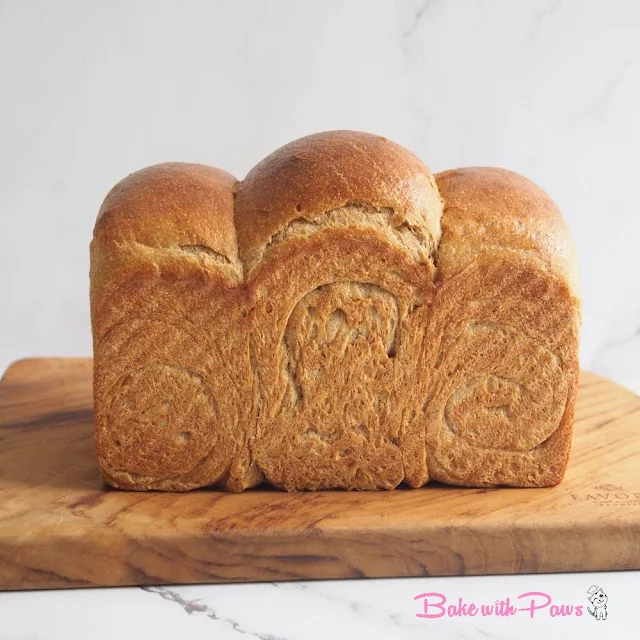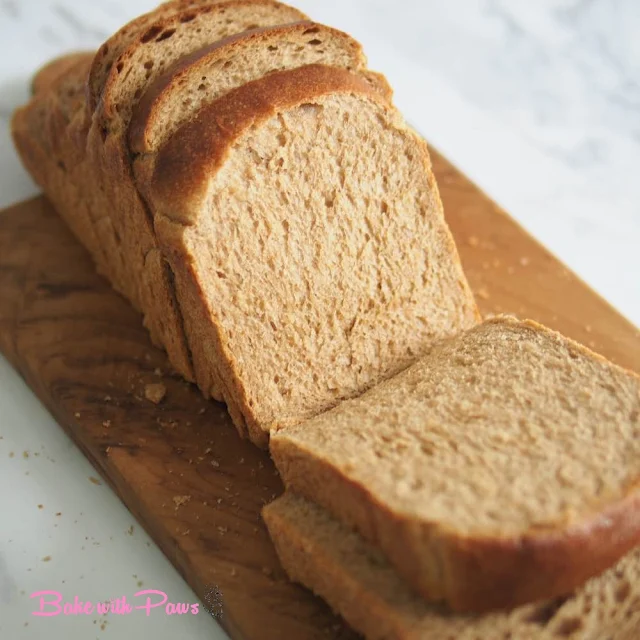Breads (Sourdough) - Soft Loaves
Whole Wheat Sourdough Sandwich Bread
October 05, 2023
| Recipe by Bake with Paws
Scroll to the bottom of the page for "PRINT RECIPE" ⬇
I made this Whole Wheat Sourdough Sandwich Bread using 92% of whole wheat flour and 8% of bread flour that comes from the sourdough starter.
I used the same approach as mentioned in my previous post "100% Whole Wheat Bread". Whole wheat flour has very little gluten and the bread doesn't rise as much as white flour bread, hence you need more flour to fill up the volume. Whole wheat flour also absorbs more liquid and it requires higher hydration.
The texture of the bread is the same as instant version, crumbly and easy to tear apart yet very soft with darker colour and a delicious nutty smell. However, the bread is more tangy compared with sourdough soft bread using white bread flour. I won't recommend this if you are not the fan of tangy bread. However, you can add 1/8 tsp of instant yeast to reduce the tangy taste.
Please take note as well whole wheat bread tends to have a shorter shelf life than normal bread due to its higher moisture content so it is best refrigerated if not consumed within a day.
How to Make Whole Wheat Sourdough Sandwich Bread
Yields: 1 loaf
INGREDIENTS:
Yudane Dough:
75g whole wheat flour (I used Bob's Red Mill Whole Wheat Flour)
85g boiling water
Sweet Stiff Starter:
60g sourdough starter (100% Hydration), use at its peak
180g whole wheat flour (I used Bob's Red Mill Whole Wheat Flour)
95g water
30g sugar (I used organic brown sugar)
Main Dough:
95g whole wheat flour (I used Bob's Red Mill Whole Wheat Flour)
All yudane dough (above)
All stiff starter (above)
15g brown sugar (I used organic brown sugar)
1 round tsp (6g) salt
50g cold egg, whisked (from 1 egg), balance use for egg wash
45g cold water
35g butter, room temperature
Egg Wash: (Optional)
1 egg + 1 Tbsp water, whisked
Utensil:
450g loaf pan (21.3 X 12.2 X 11.5 cm / 8.4" X 4.8" X 4.5")
* Please add 1/8 tsp of instant yeast to reduce the tangy taste.
METHOD:
- Yudane
- Add whole wheat flour in a bowl, pour the boiling water and mix well with spatula or spoon until no dry flour.
- Cling film and leave on the counter for at least 4 hours or overnight in the fridge. I prepared the night before.
- Use directly from the fridge.
- Sweet Stiff Starter:
- In a bowl of stand mixer, dilute starter with water, stir in sugar and add in whole wheat flour. Mix with paddle attachment until well mixed and all come together. It can be done by hand mixing too.
- Place the sweet stiff starter in a jar or back in the same mixing bowl to proof.
- Cover and let it ferment until doubles (or triples). I prepared a night before and leave it in aircond room (approximately 23C - 25C room temperature) overnight until doubles. It took about 8 - 9 hours depending on your starter. It should take around 4 - 6 hours to get triple at room temperature at 28C - 30C.
- I noticed the starter rise to the maximum until doubles only when I feed with 100% whole wheat flour.
- Main Dough:
- Put all ingredients (except butter), including all the yudane and stiff starter (slightly tear the dough) into a bowl of stand mixer.
- Slightly combine the mixture by hand with the paddle attachment before turning on the machine so that the flour will not splash out. Using the paddle attachment, mix for 2 minutes or until the dough comes together and elastic.
- I usually rested for 5 minutes before adding the butter.
- Change to hook attachment, add butter and continue knead for about 7 - 10 minutes or until reach a reasonable window pane stage. The whole kneading process, I stopped few times to scrape down the dough from the hook to be sure it is evenly kneaded and also to prevent the motor from overheating.
- 1st Proofing/Resting:
- In the same bowl, let the dough rest for 45 minutes. Keep it covered with clingfilm or use a lid. It is not required the dough to rise a lot.
- Shaping:
- Transfer the dough to a clean floured or slightly oiled surface then divide into 2 or 3 equal portions. Please use a kitchen scale if you want to be exact.
- Form each portion to a ball. Flatten with rolling pin.
- Fold right to centre and fold left overlap it. Roll out with rolling pin into long rectangle shape. Roll up the dough like Swiss Roll until a small log is formed.
- Place all dough in the prepared loaf pan.
- Final Proofing :
- Let it proof in a warm place until the dough reaches almost the height of the pan. This one took approximately 2 hours and 40 minutes at room temperature of 29C - 30C. The duration of proofing depends on your ambient temperature and starter.
- Baking:
- Preheat oven at 180C -190C (top & bottom heat) or 170C (fan-forced) for 10 - 15 minutes.
- Brush with egg wash (optional) and bake in a preheated oven for about 30 minutes, or until golden brown. You may cover the bread with aluminium foil for the last 10 minutes if the top browning too quickly.
- Remove bread from oven and let them cool on rack completely before slicing.
Yudane Dough
Sweet Stiff Starter
Main Dough
GENERAL NOTES:
SOURDOUGH STARTER
Please click this link for "How To Make Sourdough Starter" and "Sourdough Maintenance"
A healthy starter is very crucial as advised by Baking with Gina. It is advisable to feed your starter regularly if you want your bread to rise nicely and to use the starter (levain) at its peak. A starter that is fed regularly will be more active in general. If the mother starter is not strong, the bread dough will not rise a lot even though the starter is used at its peak.
GLUTEN DEVELOPMENT & WINDOWPANE TEST
Gluten forms when flour comes in contact with water. Hydration of the flour causes the sticky and stretchy protein to form, giving structure to the bread. This makes your bread trap air and rise.
Gluten in dough can be developed by autolyse, resting, kneading or folding.
The windowpane test is used to determine whether the dough has been sufficiently kneaded. By gently pulling the dough (or you may pinch off some dough) and trying to stretch it into a thin membrane. If you are able to stretch the dough paper thin and translucent without tearing, then the gluten is fully developed. However, if you can stretch it without tearing but the membrane is not transparent, then the gluten is not yet fully developed.
However, from my experience not all the recipe can achieve a thin and translucent window pane stage easily. For example low hydration and low fat dough. For such recipes, a reasonable window pane is good enough and it can be left to rest. Gluten will continue to develop while resting. Exercising restraint to not over-knead the dough prevents the gluten from being overworked and broken. Some of you may have experienced the dough breaking during the second proofing. It is because the dough is over kneaded.
The total kneading time for me is usually 15 minutes at low speeds except brioche dough with high fat percentage or dough using liquid fat which usually takes a little longer (maybe 18-20 mins).
From my experience, I found that high hydration dough with high percentage of fat will be easy to stretch and achieve a paper thin windowpane stage.
KNEADING TIME
For kneading, please regard the timing provided as an indication only. It is only meant as a guide. Timing may differ depending on the brand of flour and electric mixer used. The protein content may vary from one brand of flour to another.
FLOUR
The right flour plays a very important role in bread making. To achieve fluffy, soft and light bread, I used Japan High Gluten Flour in most of my bread baking. The protein content is around 12 - 13%.
HYDRATION
The liquid measurement given is also a guide. It is advisable to always reserve some liquid and not add it all in one go. This would give you the opportunity to adjust if necessary. If dough is too dry, add the reserve liquid one tablespoon at a time until the right consistency. This is because each flour absorbs water and hydrates differently.
PROOFING
Please note that the proofing timing may also vary depending on your climate, environment, flour and your starter.
If you are unable to judge by just looking at the dough, you can do the finger poke test:
- Lightly press the side of the proved dough with your finger. If it bounces back immediately without any indentation, it means the dough is under proved and needs more time before baking.
- If the indentation stays and it doesn’t bounce back, it means it has been over proved.
- If the indentation slowly bounces back and leave a small indentation, it is ready to bake.
- There will be a final burst of rising once the bread is placed to bake in the oven and it is called oven spring.
If your bread collapses or gets wrinkled on top after removing from oven, it could be because your dough over proved during the second proofing. Please proof until the tip of the dough just reaches the rim of the pan, around 80% - 90% in size.
BAKING TEMPERATURE AND TIME
Do also note that the baking temperature and timing provided are what works for my oven and should also be regarded as a guide only. Every oven behaves a little differently, so please adjust accordingly for your oven.
Labels:
Breads (Sourdough) - Soft Loaves,








Thank you so much sis ❤❤❤❤❤ will try it soon ❤🩹🙏
ReplyDeleteYou are most welcome! Hope you will like it too :)
DeleteThanks
HI can i ask about the size of pan ?
ReplyDeleteHi, sure. It is 450g non stick loaf pan (21.3 X 12.2 X 11.5 cm / 8.4" X 4.8" X 4.5"). Sorry, I have accidentally deleted from the recipe. I just updated it.
DeleteCheers and happy baking :)
Thank you
DeleteHi can i complete Final Proofing in fridge 12 h
ReplyDeleteHi, I have not tried this method because the final proofing took quite fast for me in this recipe as I used very high percentage of sweet stiff starter. You can try but the bread going to be very sour.
DeleteCheers :)
Thank you, I tried the recipe yesterday
DeleteI was very happy with the result. The first sourdough toast I made was fluffy
I want to ask if I can omit the eggs and replace them with water
Hi, You are most welcome. Thank you for trying and glad that you are happy with it. You can replace eggs with water or milk. I used egg to cut down the sour smell and taste.
DeleteCheers :)
Hi><
DeleteCan I use the recipe to make burger buns or Rolls like this recipe (Rosemary Olive Soft Sourdough Rolls)?
Hi, thanks for your interest in this recipe. Yes, of course you can. Make any shapes that you like ya.
DeleteCheers and happy baking :)
Thank you, I loved your recipes
DeleteI adopted this recipe , and yesterday I made the Spelt Soft Sourdough Bread recipe and it was amazing
Hi, my pleasure! Thank you for trying and your kind feedback. It means a lot to me :)
DeleteHi what can we substitute egg with
ReplyDeleteHi, You can replace with milk or water.
DeleteThanks